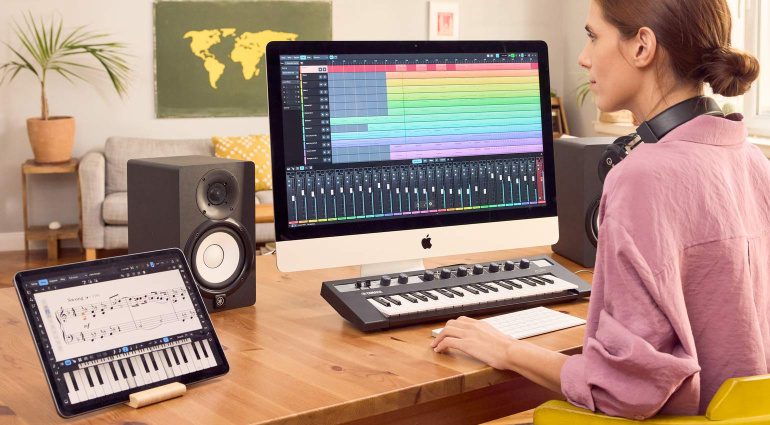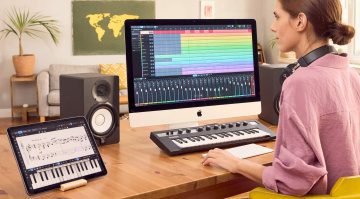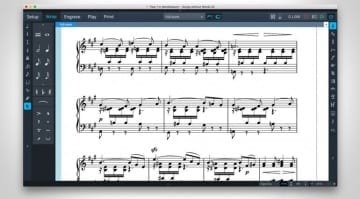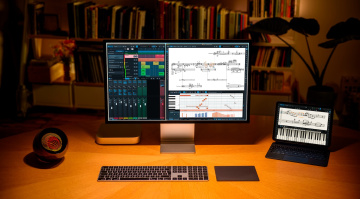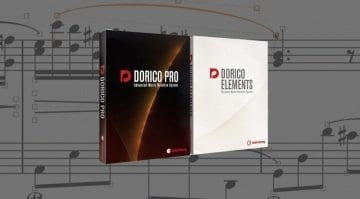Steinberg Dorico 4 notation software: more features, less dongles
Steinberg has released Dorico 4. The major update to the professional music notation and composition software comes with a long list of new features and workflow enhancements. It also marks Steinberg’s much-anticipated abolishment of the eLicenser dongle in favor of a new, identity-based license management system. Oh, and it supports Apple Silicon, too.
Steinberg Dorico 4
Steinberg’s press release for Dorico 4 is a whopping six pages long. The list of new features that have been added to the software is quite impressive, and if you’re a Dorico user, I recommend that you check it out in its entirety on Steinberg’s website.
To begin with, Steinberg has made a number of improvements to the way Dorico imports, records and plays back MIDI data. In Write mode, there’s now a dedicated Key Editor in the lower zone, which is automatically kept in sync with the notation in the upper half of the screen. Steinberg says that this makes it easy to edit continuous controllers, dynamics and velocities and shape the MIDI performance of your score. That should be a great time saver for orchestral mock-ups and other applications where MIDI playback is critical.
The new Key Editor isn’t the only new feature in the lower zone. Dorico 4 also offers three new on-screen instruments for quicker note input. The new on-screen keyboard, fretboard and drum pads are touch-enabled on Windows devices with touch screens. You can click or tap notes into the score on the keyboard, input guitar tab notation using the virtual fretboard and string, and unleash your inner percussionist with the drum pads.
Polyphonic MIDI Transcription
Dorico 4 also includes improvements to the MIDI import workflow. Steinberg says that the new Smart MIDI Import feature intelligently interprets incoming tracks and remembers your choices, which is supposed to make the import of large orchestral arrangements much quicker and less tedious. Furthermore, the software now offers Polyphonic MIDI Transcription for automatic separation of melodies, bass lines and inner textures into individual voices. This works on imported scores and live performances alike.
Insert mode, one of Dorico’s unique features, has been enhanced with an editable stop position. It’s also now possible to limit the scope of Insert mode operations to individual voices, all voices on the current instrument, or all instruments in the flow. And while you’re making edits in Insert mode, you can now decide if the music should be pushed forwards into the following bars or if the current bar should be enlarged, which makes it easy to create cadenzas or free rhythm sections, Steinberg says.
Dorico 4 also provides quick access to common rhythmic and melodic transformations like rotation, inversion and reversal. Steinberg points out that these aren’t plug-ins, but rather deep integrations that work on notes and all other notational elements such as slurs, dynamics, techniques, etc.
Other new features include a revamped Play mode, completely rebuilt mixer, new library manager, and many more workflow enhancements and improvements.
Apple Silicon support and new licensing system
The update also brings native Apple Silicon support to Dorico. Steinberg says that it’s the first professional music notation software that runs natively on M1-powered Macs – it’s about time! The company also claims that some operations are twice as fast on Apple Silicon than on Intel-powered machines.
And finally, there’s the new licensing system. We already knew that Steinberg was getting ready to ditch the eLicenser dongle and that Dorico 4 was going to be the first release with the new system. And it’s true: You don’t need a USB dongle anymore, and you can run the software on up to three computers with a single license by signing in on each machine. The new licensing system will later be brought to the upcoming Cubase 12 and presumably Nuendo, as well.
Price and compatibility
Steinberg Dorico 4 comes in four versions: Pro, Elements, SE and Dorico for iPad. A full license for Dorico Pro 4 costs €579 or $579.99. Users of Finale or Sibelius can take advantage of a discounted crossgrade offer for €299/$299.99.
Dorico Elements 4 is €99.99/$99.99. The introductory version Dorico SE 4 is free.
Various educational discounts, updates, upgrades, and crossgrades are available from the Steinberg website. And if you’ve bought Dorico 3.5 or an earlier version on or after August 25, 2021, you’re eligible for a free grace period update to the latest respective version.
The software runs on macOS Mojave, Catalina, Big Sur and Monterey, Windows 10 21H2 or higher (64 bit) and Windows 11 21H2 or higher (64 bit).
Dorico for iPad is available as a free download from the App Store. You can unlock additional functionality by purchasing an in-app subscription for €3.99/$3.99 per month or €39.99/$39.99 per year.
More information about Steinberg Dorico 4
Video
You are currently viewing a placeholder content from YouTube. To access the actual content, click the button below. Please note that doing so will share data with third-party providers.
